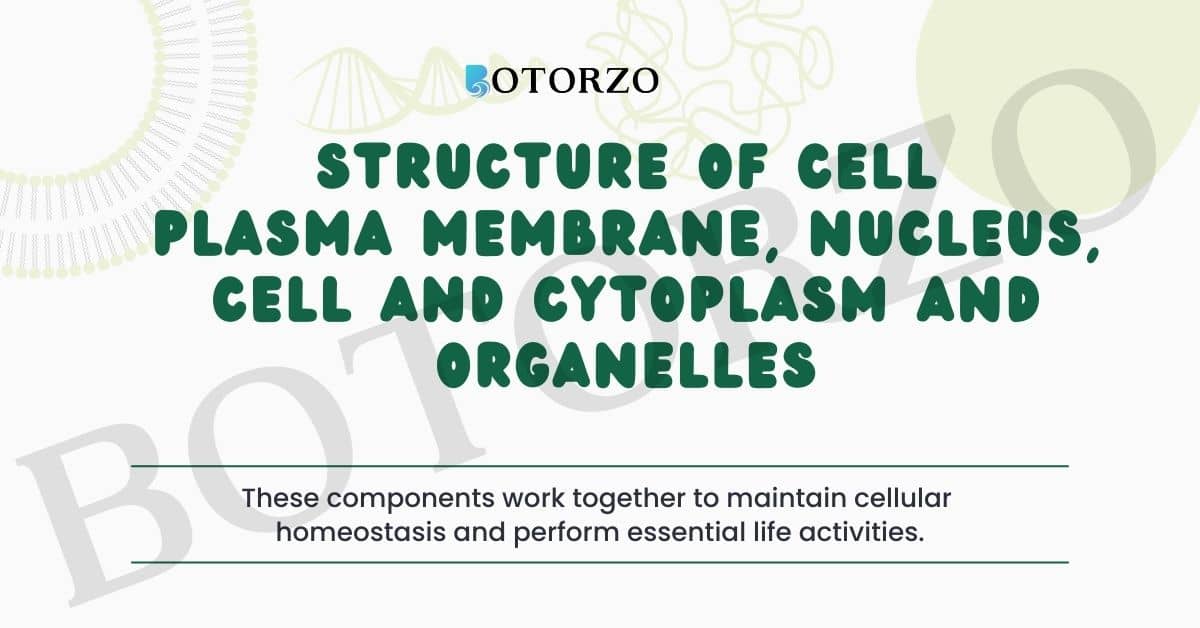The structure of cell is a remarkable and complex realm that underpins life. Cells, the basic units of life, display intricate organization and diversity. This brief introduction will provide a glimpse into the microscopic world where life’s fundamental processes unfold.
A cell, whether a single-celled organism or part of a larger organism, shares the core structure of a cell. From the cell membrane to the nucleus and mitochondria, these components work together to enable life’s functions.
Join us on this journey to explore cell structure, where the invisible becomes visible, and the wonders of life’s building blocks are unveiled. Understanding cell structure is the gateway to unraveling the mysteries of biology and the marvels of the living world.
structure of cell
When looking at a cell under a microscope, three basic components stand out: the plasma membrane, the nucleus, and the cytoplasm. These three components are the foundation of a cell’s functionality and interactions with its surroundings.
The plasma membrane serves as a protective barrier, allowing substances to enter and exit the cell selectively. It is critical for maintaining the cell’s integrity and controlling the flow of vital materials. Meanwhile, the nucleus acts as the cell’s command center, housing its genetic material and orchestrating its activities. Finally, the cytoplasm, a gel-like substance that houses various organelles and biochemical processes, provides the environment for vital cellular functions. These components work together to allow a cell to perform essential tasks and interact with its surroundings, ensuring the intricate web of life’s processes within.
Plasma Membrane or Cell Membrane
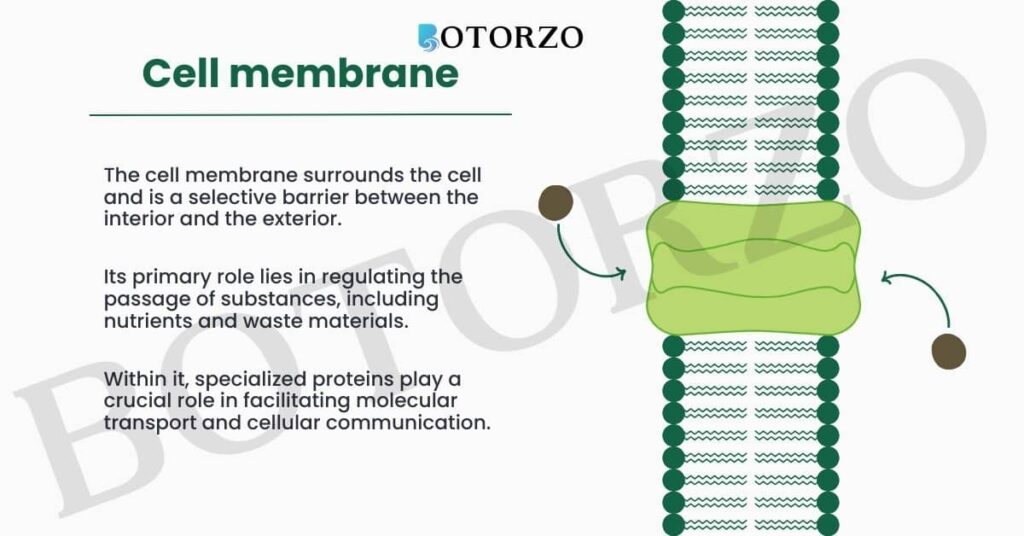
The plasma membrane, a cell’s outermost boundary, is critical in maintaining the delicate balance between the cell’s internal contents and the external environment. This semi-permeable barrier protects the cell by selectively allowing certain substances to enter or exit while preventing others from entering or exiting. The plasma membrane functions as a sophisticated gatekeeper, determining what materials can and cannot pass through it, which is critical for the cell’s survival and well-being.
One of the plasma membrane’s most remarkable properties is its ability to regulate the flow of specific molecules. It allows essential nutrients and ions to enter the cell, ensuring that the cell receives the resources it requires to function properly. At the same time, it acts as a barrier against potentially harmful substances, protecting the cell from potential threats. The plasma membrane’s selective permeability is what makes it a linchpin in cell survival, allowing it to maintain internal conditions and the intricate biochemical processes that define life. In essence, the plasma membrane serves as the cell’s protector, carefully controlling material exchange to ensure the cell’s health and proper functioning.
diffusion
The movement of substances into and out of cells is critical for their survival. As previously discussed, compounds such as carbon dioxide and oxygen can naturally diffuse through the cell membrane, moving from areas of higher concentration to areas of lower concentration. When waste products, such as CO2, accumulate significantly within cells, with a higher concentration inside the cell than outside, diffusion causes CO2 to exit the cell. Oxygen (O2), on the other hand, enters the cell as its internal concentration falls. This process, known as diffusion, is critical in regulating gas exchange between cells and their surroundings, thereby maintaining the balance of these vital substances.
Osmosis
Solute concentration governs osmosis, the movement of water through a selectively permeable membrane. It causes a net flow of water to areas with higher solute concentrations. When the external environment is more solute-rich than the cell’s interior, water exits the cell, whereas when the cell’s solute concentration is higher, water enters. Osmosis preserves cell integrity, regulates water and solute levels, and has a significant impact on overall cell health.
solutions
| Solution Type | Water Concentration Relative to Cell | Water Movement Across Cell Membrane | Cell Response |
|---|---|---|---|
| Hypotonic | Higher (Dilute Solution) | More water enters than leaves | Cell swells (may undergo lysis) |
| Isotonic | Equal | Equal movement in both directions | Cell remains unchanged |
| Hypertonic | Lower (Concentrated Solution) | More water leaves than enters | Cell shrinks (plasmolysis) |
Hypotonic Solution:
- Water Concentration Relative to Cell: Higher (Dilute Solution)
- Water Movement Across Cell Membrane: More water enters than leaves
- Cell Response: Cell swells (may undergo lysis)
Isotonic Solution:
- Water Concentration Relative to Cell: Equal
- Water Movement Across Cell Membrane: Equal movement in both directions
- Cell Response: The cell remains unchanged
Hypertonic Solution:
- Water Concentration Relative to Cell: Lower (Concentrated Solution)
- Water Movement Across Cell Membrane: More water leaves than enters
- Cell Response: Cell shrinks (plasmolysis)
Cell wall
Cell walls, which distinguish plant, fungi, and bacterial cells, allow these organisms to absorb water via osmosis without the risk of bursting in extremely dilute (hypotonic) external environments. When immersed in such media, these cells tend to take up water via osmosis, resulting in cell swelling and pressure against the cell wall. In turn, the cell wall exerts opposing pressure on the swollen cell. This distinct adaptation enables these cells to withstand significant changes in their surrounding environment, distinguishing them from animal cells, which lack such protective structures.
plasmolysis
Plasmolysis is a critical phenomenon in plant biology that occurs when a living plant cell loses water via osmosis, causing the cell’s contents to shrink and move away from the cell wall due to a decrease in turgor pressure, which is the pressure exerted by the cell’s contents against the cell wall.
Nucleus
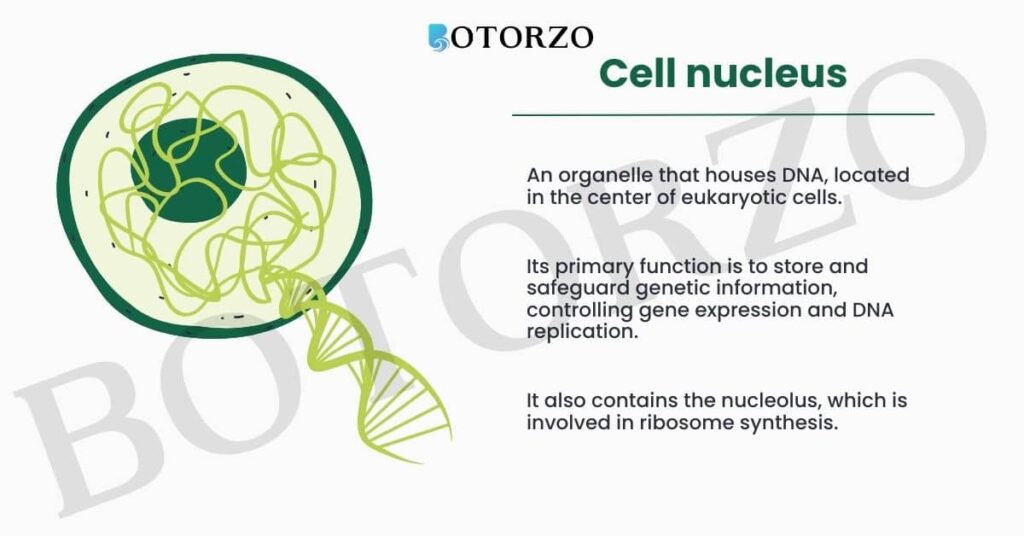
The nucleus is a critical component of the cell, containing chromosomes and DNA molecules that carry genetic information for inheritance. While chromosomes appear as rod-shaped structures when the cell is preparing to divide, DNA is part of the chromatin material in non-dividing cells, presenting as a complex, thread-like structure. The nucleus is important not only for cellular reproduction, but also for guiding the cell’s development and ultimate form by regulating chemical activities, a process that is heavily influenced by the cellular environment.
In some organisms, such as bacteria, the nucleus is poorly defined due to the lack of a nuclear membrane, resulting in a nucleoid. Prokaryotes are such organisms, whereas eukaryotes have a nuclear membrane. Many cytoplasmic organelles found in eukaryotic cells are absent in prokaryotic cells, with some functions performed by less organised cytoplasmic components. For example, chlorophyll in photosynthetic prokaryotic bacteria is associated with membranous vesicles rather than plastids as in eukaryotic cells.
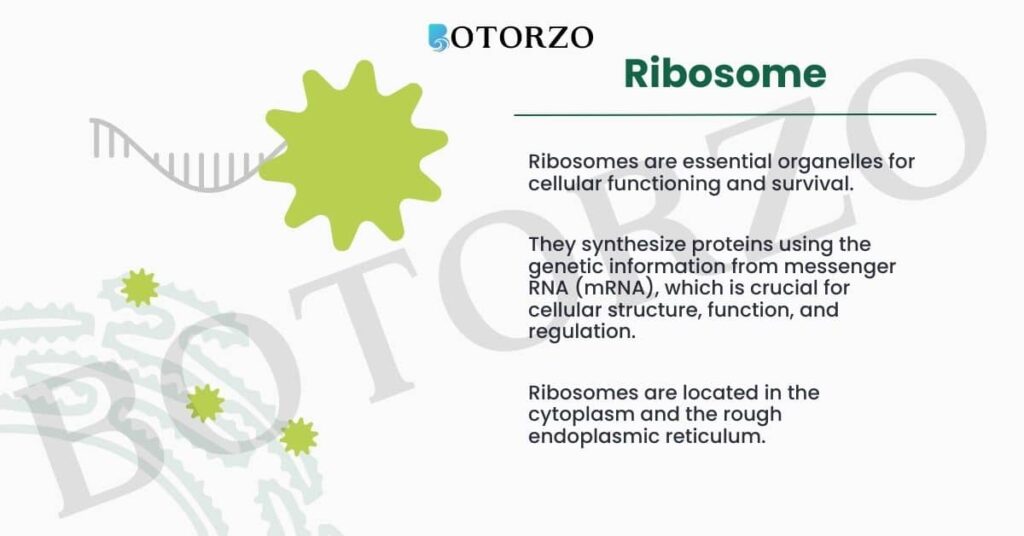
Nuclear membrane
The nucleus is surrounded by a double-layered structure known as the nuclear membrane, which contains pores that allow materials to pass between the nucleus and the cytoplasm outside.
Also read: What Is A Cell, Types Of Cell, Prokaryotic And Eukaryotic
Cytoplasm
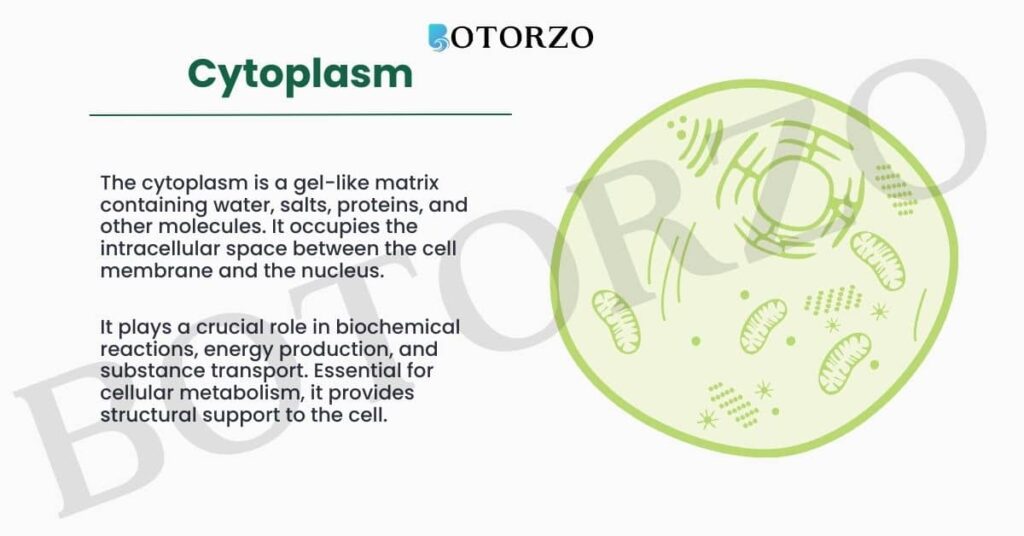
The cytoplasm, the fluid content enclosed by the cell membrane, is visible when onion peels and human cheek cell mounts are examined. It is made up of membrane-enclosed, specialized cell organelles, each with a specific function. Like bacteria, prokaryotic cells lack a defined nuclear region as well as membrane-bound organelles. Eukaryotic cells, on the other hand, have a nuclear membrane and membrane-enclosed organelles. Viruses, which lack these membranes and only exhibit life characteristics when inside a living organism and use the host’s cellular machinery for replication, demonstrate the importance of these membranes.
Cell Organelles
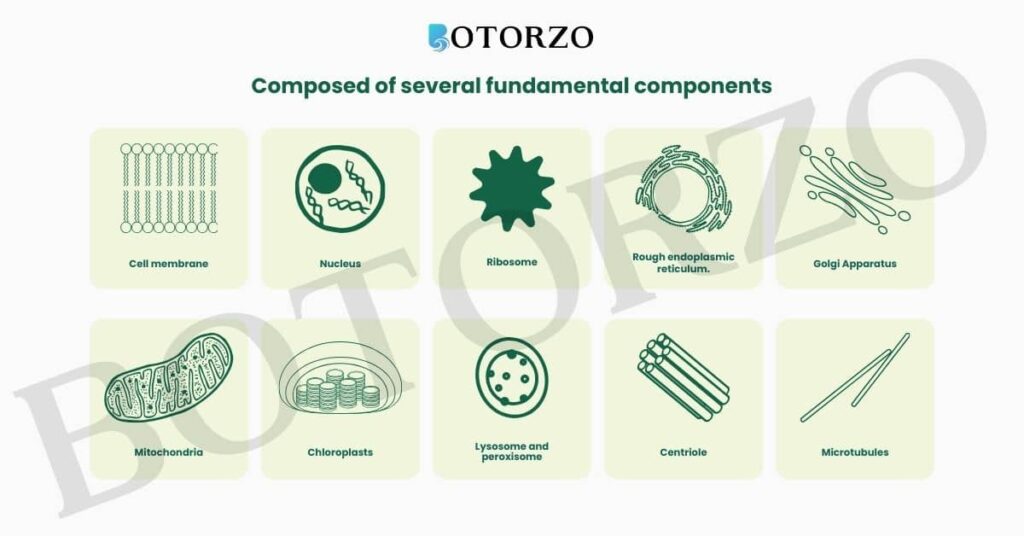
Each cell contains a protective membrane that acts as a wall, separating the inside contents of the cell from the outside world. All cells have this essential membrane as a basic characteristic. Large and sophisticated cells, such as those seen in multicellular creatures, need a multitude of precise chemical reactions to maintain their complicated structure and activities. Inside their borders, these cells employ tiny, membrane-bound structures called “organelles” to preserve order and avoid interference between their diverse tasks. This is a crucial characteristic that distinguishes prokaryotic from eukaryotic cells. It should be mentioned that some of these organelles are so tiny that an electron microscope is the only way to observe them.
Organelles are the miniature machines that make a cell’s processes run smoothly. They are particularly vital in eukaryotic cells, where each organelle plays a specific role.
Endoplasmic Reticulum (ER)
The endoplasmic reticulum plays a pivotal role in material transport and maintains the cytoplasm’s framework. We’ll delve into its functions and significance.
Golgi Apparatus
The Golgi apparatus is responsible for packaging and modifying cellular products. We’ll explain its role in processing and shipping cellular materials.
Lysosomes
Lysosomes act as “suicide bags” within the cell, breaking down waste materials and cellular debris. We’ll uncover their importance in maintaining cell cleanliness.
Mitochondria
Often referred to as the “powerhouses” of the cell, mitochondria are responsible for energy production. We’ll explore the process of ATP production and the unique features of mitochondrial DNA.
Plastids (in Plant Cells)
Plastids, such as chloroplasts and leucoplasts, are exclusive to plant cells and play a pivotal role in photosynthesis and storage.
Vacuoles
Vacuoles serve as storage sacs in both animal and plant cells, with varying sizes and functions. We’ll discuss their roles in maintaining cell turgidity and rigidity.
Read Also About Engineering
frequently asked question
What is the role of the plasma membrane in a cell?
The plasma membrane acts as a protective barrier, regulating the passage of substances in and out of the cell. It selectively allows certain substances to enter or exit while preventing others, maintaining the cell’s integrity.
What is diffusion, and how does it affect cellular processes?
Diffusion is the process of substances moving into and out of cells, vital for their survival. It allows molecules like carbon dioxide and oxygen to naturally flow through the cell membrane, maintaining a balance of these crucial substances.
How does osmosis work, and why is it important for cells?
Osmosis is the movement of water through a selectively permeable membrane, driven by differences in solute concentration. It regulates water and solute levels in cells, affecting their overall health and integrity.
What is plasmolysis in plant cells, and why is it significant?
Plasmolysis is the shrinkage of a plant cell’s contents due to water loss via osmosis. It results in a decrease in turgor pressure, which is essential for the cell’s structural integrity and overall health.
What are the main functions of the nucleus in a cell?
The nucleus houses chromosomes and DNA molecules, carrying genetic information for inheritance. It plays a crucial role in cellular reproduction, development, and regulating chemical activities within the cell.
What distinguishes prokaryotic cells from eukaryotic cells?
Prokaryotic cells lack a nuclear membrane, while eukaryotic cells have one. Eukaryotic cells also contain membrane-bound organelles, which are absent in prokaryotic cells.
What are organelles in a cell, and why are they important?
Organelles are membrane-bound structures within a cell that serve specific functions. They are crucial for maintaining order and efficiency within the cell, especially in eukaryotic cells.
What makes mitochondria the “powerhouses” of the cell?
Mitochondria are responsible for energy production, particularly in the form of ATP. They are essential for a cell’s energy needs, and they possess unique mitochondrial DNA.
Why are lysosomes referred to as “suicide bags” in a cell?
Lysosomes play a vital role in breaking down waste materials and cellular debris, effectively cleaning and maintaining the cell, which is why they are sometimes called “suicide bags.”
What is the role of vacuoles in both animal and plant cells?
Vacuoles serve as storage sacs in cells and differ in size between animal and plant cells. They help maintain cell turgidity and rigidity.
What are plastids in plant cells, and what are their functions?
Plastids, including chloroplasts and leucoplasts, are exclusive to plant cells and are crucial for photosynthesis and storage processes.
How does the Golgi apparatus contribute to cellular processes?
The Golgi apparatus is responsible for packaging and modifying cellular products, facilitating the processing and shipping of materials within the cell.

